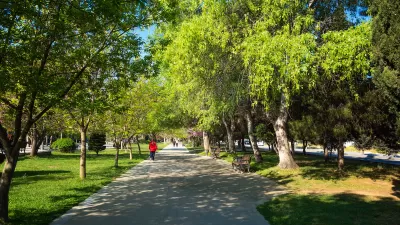The city has outlined 11 strategic priorities aimed at addressing the risks of extreme heat and protecting vulnerable residents from its impacts.

A plan dubbed ‘Shade Phoenix’ pledges to plant 27,000 trees and build 550 shade structure in Phoenix in the next five years to tackle the growing problem of extreme heat.
In a piece for Environment and Energy Leader, Kaleigh Harrison explains that the initiative is part of the city’s Office of Heat Response and Mitigation, the first such department in the nation. “The Shade Phoenix Plan includes 36 action items and 11 strategic priorities aimed at reducing heat vulnerability. These initiatives incorporate cooling strategies like cool corridors and heat-reducing materials.”
The plan also emphasizes equity, noting that resources should be fairly distributed among the city’s neighborhoods and address the needs of communities most vulnerable to extreme heat. “City officials stress that shade infrastructure is essential public health infrastructure, not just an aesthetic upgrade. Extensive community outreach shaped the plan, ensuring it addresses diverse.”
FULL STORY: Phoenix Launches Shade Plan to Tackle Urban Heat Crisis

Manufactured Crisis: Losing the Nation’s Largest Source of Unsubsidized Affordable Housing
Manufactured housing communities have long been an affordable housing option for millions of people living in the U.S., but that affordability is disappearing rapidly. How did we get here?

Americans May Be Stuck — But Why?
Americans are moving a lot less than they once did, and that is a problem. While Yoni Applebaum, in his highly-publicized article Stuck, gets the reasons badly wrong, it's still important to ask: why are we moving so much less than before?

Using Old Oil and Gas Wells for Green Energy Storage
Penn State researchers have found that repurposing abandoned oil and gas wells for geothermal-assisted compressed-air energy storage can boost efficiency, reduce environmental risks, and support clean energy and job transitions.

Updating LA’s Tree Rules Could Bring More Shade to Underserved Neighborhoods
A new USC study finds that relaxing Los Angeles’ outdated tree planting guidelines could significantly expand urban tree canopy and reduce shade disparities in lower-income neighborhoods, though infrastructure investments are also needed.

California's Canal Solar Projects Aim to Conserve Resources and Expand Clean Energy
California’s Project Nexus has begun generating electricity from solar panels installed over irrigation canals, with researchers and state agencies exploring statewide expansion to conserve water and boost clean energy production.

HHS Staff Cuts Gut Energy Assistance Program
The full staff of a federal program that distributes heating and cooling assistance for low-income families was laid off, jeopardizing the program’s operations.
Urban Design for Planners 1: Software Tools
This six-course series explores essential urban design concepts using open source software and equips planners with the tools they need to participate fully in the urban design process.
Planning for Universal Design
Learn the tools for implementing Universal Design in planning regulations.
Heyer Gruel & Associates PA
City of Moreno Valley
Institute for Housing and Urban Development Studies (IHS)
City of Grandview
Harvard GSD Executive Education
Salt Lake City
NYU Wagner Graduate School of Public Service
City of Cambridge, Maryland





























